PrFeTiO5-Based Chemoresistive Gas Sensors for VOCs Detection
Abstract
1. Introduction
2. Materials and Methods
2.1. Chemicals
2.2. Synthesis of PrFeTiO5
2.3. Film Deposition and Sensor Development
2.4. Materials and Functional Films Characterization
2.5. Gas-Sensing Measurements
3. Results
3.1. Structural, Morphological, and Chemical Characterization
3.2. Gas-Sensing Performance
4. Discussion
5. Conclusions
Supplementary Materials
Author Contributions
Funding

Institutional Review Board Statement
Informed Consent Statement
Data Availability Statement
Conflicts of Interest
Abbreviations
| VOCs | Volatile Organic Compounds |
| GC | Gas Chromatography |
| MS | Mass Spectrometry |
| MOX | Metal Oxide |
| RT | Room Temperature |
| RH% | % of Relative Humidity |
| MFC | Mass-Flow Controller |
| XRPD | X-Ray Powder Diffraction |
| SEM | Scanning Electron Microscopy |
| EDS | Energy Dispersive Spectrometry |
| HRTEM | High-Resolution Transmission Electron Microscope |
| FIB | Focused Ion Beam |
| STEM | Scanning Transmission Electron Microscope |
| UV-Vis-NIR | Ultra-Violet–Visible–Near Infrared |
| FWHM | Full Width at Half Maximum |
References
- Epping, R.; Koch, M. On-Site Detection of Volatile Organic Compounds (VOCs). Molecules 2023, 28, 1598. [Google Scholar] [CrossRef] [PubMed]
- Lin, T.; Lv, X.; Hu, Z.; Xu, A.; Feng, C. Semiconductor Metal Oxides as Chemoresistive Sensors for Detecting Volatile Organic Compounds. Sensors 2019, 19, 233. [Google Scholar] [CrossRef]
- Pecunia, V.; Petti, L.; Andrews, J.B.; Ollearo, R.; Gelinck, G.H.; Nasrollahi, B.; Jailani, J.M.; Li, N.; Kim, J.H.; Ng, T.N.; et al. Roadmap on Printable Electronic Materials for Next-Generation Sensors. Nano Futures 2024, 8, 032001. [Google Scholar] [CrossRef]
- Stetter, J.R.; Stetter, E.F.; Carter, M.T. Abundant Chemical Sensors and the Trillion Sensor Universe. ECS Meet. Abstr. 2014, MA2014-01, 451. [Google Scholar] [CrossRef]
- Spagnoli, E.; Krik, S.; Fabbri, B.; Valt, M.; Ardit, M.; Gaiardo, A.; Vanzetti, L.; Della Ciana, M.; Cristino, V.; Vola, G.; et al. Development and Characterization of WO3 Nanoflakes for Selective Ethanol Sensing. Sens. Actuators B Chem. 2021, 347, 130593. [Google Scholar] [CrossRef]
- Saruhan, B.; Lontio Fomekong, R.; Nahirniak, S. Review: Influences of Semiconductor Metal Oxide Properties on Gas Sensing Characteristics. Front. Sens. 2021, 2, 657931. [Google Scholar] [CrossRef]
- Korotcenkov, G. The Role of Morphology and Crystallographic Structure of Metal Oxides in Response of Conductometric-Type Gas Sensors. Mater. Sci. Eng. R Rep. 2008, 61, 1–39. [Google Scholar] [CrossRef]
- Gao, X.; Zhang, T. An Overview: Facet-Dependent Metal Oxide Semiconductor Gas Sensors. Sens. Actuators B Chem. 2018, 277, 604–633. [Google Scholar] [CrossRef]
- Rudel, H.E.; Lane, M.K.M.; Muhich, C.L.; Zimmerman, J.B. Toward Informed Design of Nanomaterials: A Mechanistic Analysis of Structure–Property–Function Relationships for Faceted Nanoscale Metal Oxides. ACS Nano 2020, 14, 16472–16501. [Google Scholar] [CrossRef]
- Yang, Y.; Hong, A.; Liang, Y.; Xu, K.; Yu, T.; Shi, J.; Zeng, F.; Qu, Y.; Liu, Y.; Ding, M.; et al. High-Energy {001} Crystal Facets and Surface Fluorination Engineered Gas Sensing Properties of Anatase Titania Nanocrystals. Appl. Surf. Sci. 2017, 423, 602–610. [Google Scholar] [CrossRef]
- Xu, J.; Xue, Z.; Qin, N.; Cheng, Z.; Xiang, Q. The Crystal Facet-Dependent Gas Sensing Properties of ZnO Nanosheets: Experimental and Computational Study. Sens. Actuators B Chem. 2017, 242, 148–157. [Google Scholar] [CrossRef]
- Zhu, L.-Y.; Ou, L.-X.; Mao, L.-W.; Wu, X.-Y.; Liu, Y.-P.; Lu, H.-L. Advances in Noble Metal-Decorated Metal Oxide Nanomaterials for Chemiresistive Gas Sensors: Overview. Nano-Micro Lett. 2023, 15, 89. [Google Scholar] [CrossRef] [PubMed]
- Staerz, A.F.; Seo, H.G.; Tuller, H.L. Surface Electron Modulation of Metal Oxide-based Electrochemical Devices by Surface Additives—Linking Sensors and Fuel Cells. J. Am. Ceram. Soc. 2024, 107, 1959–1973. [Google Scholar] [CrossRef]
- Zhu, M.; Zhang, H.; Zhang, S.; Yao, H.; Shi, X.; Xu, S. Chemoresistive Gas Sensors Based on Noble-Metal-Decorated Metal Oxide Semiconductors for H2 Detection. Materials 2025, 18, 451. [Google Scholar] [CrossRef]
- Shah, V.; Bhaliya, J.; Patel, G.M.; Joshi, P. Recent Advancement in Pd-Decorated Nanostructures for Its Catalytic and Chemiresistive Gas Sensing Applications: A Review. Top. Catal. 2022, 1–41. [Google Scholar] [CrossRef]
- Cheng, Y.; Guo, H.; Wang, Y.; Zhao, Y.; Li, Y.; Liu, L.; Li, H.; Duan, H. Low Cost Fabrication of Highly Sensitive Ethanol Sensor Based on Pd-Doped α-Fe2O3 Porous Nanotubes. Mater. Res. Bull. 2018, 105, 21–27. [Google Scholar] [CrossRef]
- Degler, D.; Weimar, U.; Barsan, N. Current Understanding of the Fundamental Mechanisms of Doped and Loaded Semiconducting Metal-Oxide-Based Gas Sensing Materials. ACS Sens. 2019, 4, 2228–2249. [Google Scholar] [CrossRef]
- Hunter, G.W.; Akbar, S.; Bhansali, S.; Daniele, M.; Erb, P.D.; Johnson, K.; Liu, C.-C.; Miller, D.; Oralkan, O.; Hesketh, P.J.; et al. Editors’ Choice—Critical Review—A Critical Review of Solid State Gas Sensors. J. Electrochem. Soc. 2020, 167, 037570. [Google Scholar] [CrossRef]
- Jamnani, S.R.; Moghaddam, H.M.; Leonardi, S.G.; Neri, G.; Ferlazzo, A. VOCs Sensing Properties of Samarium Oxide Nanorods. Ceram. Int. 2024, 50, 403–411. [Google Scholar] [CrossRef]
- Arun Kumar, K.L.; Durgajanani, S.; Jeyaprakash, B.G.; Balaguru Rayappan, J.B. Nanostructured Ceria Thin Film for Ethanol and Trimethylamine Sensing. Sens. Actuators B Chem. 2013, 177, 19–26. [Google Scholar] [CrossRef]
- Chi Tsang, S.; Bulpitt, C. Rare Earth Oxide Sensors for Ethanol Analysis. Sens. Actuators B Chem. 1998, 52, 226–235. [Google Scholar] [CrossRef]
- Sharma, N.; Choudhury, S.P. Gas Sensing Using Metal Oxide Semiconductor Doped with Rare Earth Elements: A Review. Mater. Sci. Eng. B 2024, 307, 117505. [Google Scholar] [CrossRef]
- Spagnoli, E.; Gaiardo, A.; Fabbri, B.; Valt, M.; Krik, S.; Ardit, M.; Cruciani, G.; Della Ciana, M.; Vanzetti, L.; Vola, G.; et al. Design of a Metal-Oxide Solid Solution for Sub-Ppm H2 Detection. ACS Sens. 2022, 7, 573–583. [Google Scholar] [CrossRef]
- Spagnoli, E.; Fabbri, B.; Gaiardo, A.; Valt, M.; Ardit, M.; Krik, S.; Cruciani, G.; Della Ciana, M.; Vanzetti, L.; Vola, G.; et al. Design of a Metal-Oxide Solid Solution for Selective Detection of Ethanol with Marginal Influence by Humidity. Sens. Actuators B Chem. 2022, 370, 132426. [Google Scholar] [CrossRef]
- de Lacy Costello, B.P.J.; Ewen, R.J.; Ratcliffe, N.M.; Sivanand, P.S. Thick Film Organic Vapour Sensors Based on Binary Mixtures of Metal Oxides. Sens. Actuators B Chem. 2003, 92, 159–166. [Google Scholar] [CrossRef]
- Peng, S.; Ma, M.; Yang, W.; Wang, Z.; Wang, Z.; Bi, J.; Wu, J. Acetone Sensing with Parts-per-Billion Limit of Detection Using a BiFeO3-Based Solid Solution Sensor at the Morphotropic Phase Boundary. Sens. Actuators B Chem. 2020, 313, 128060. [Google Scholar] [CrossRef]
- Ueda, T.; Kamura, S.; Shimizu, Y.; Hyodo, T. Effects of Thickness of CeO2-Added Au Electrodes of YSZ-Based Gas Sensors on VOC-Sensing Properties. Sens. Actuators B Chem. 2024, 417, 136217. [Google Scholar] [CrossRef]
- Zakaria, S.A.; Ahmadi, S.H.; Amini, M.H. CeO2/Ni-Al Layered Double Hydroxide Composite as a Gas Sensor for Volatile Organic Compounds Detection. Mater. Today Commun. 2024, 40, 109677. [Google Scholar] [CrossRef]
- Ortega, P.P.; Gherardi, S.; Spagnoli, E.; Fabbri, B.; Landini, N.; Malagù, C.; Macchi, C.; Aldao, C.M.; Ponce, M.A.; Simões, A.Z.; et al. Deciphering the CO Sensing Mechanisms of CeO2-Based Nanostructured Semiconductors: Influence of Doping, Morphology, and Humidity. Sens. Actuators B Chem. 2025, 440, 137921. [Google Scholar] [CrossRef]
- Ueda, T.; Hayashi, H.; Tsukahara, R.; Shimizu, Y.; Hyodo, T. Effects of Structure and Thickness of Ce0.9Pr0.1O2 Electrodes of YSZ-Based Gas Sensors on VOC-Sensing Properties. Sens. Actuators B Chem. 2025, 422, 136580. [Google Scholar] [CrossRef]
- Fois, M.; Cox, T.; Ratcliffe, N.; de Lacy Costello, B. Rare Earth Doped Metal Oxide Sensor for the Multimodal Detection of Volatile Organic Compounds (VOCs). Sens. Actuators B Chem. 2021, 330, 129264. [Google Scholar] [CrossRef]
- Shailja; Singh, K.J.; Sharma, S. Selective Xylene Sensor Employing Europium-Doped Nickel Oxide Nanoparticles. J. Mater. Sci. Mater. Electron. 2022, 33, 26243–26262. [Google Scholar] [CrossRef]
- Gaiardo, A.; Zonta, G.; Gherardi, S.; Malagù, C.; Fabbri, B.; Valt, M.; Vanzetti, L.; Landini, N.; Casotti, D.; Cruciani, G.; et al. Nanostructured SmFeO3 Gas Sensors: Investigation of the Gas Sensing Performance Reproducibility for Colorectal Cancer Screening. Sensors 2020, 20, 5910. [Google Scholar] [CrossRef]
- Ahmadnia-Feyzabad, S.; Mortazavi, Y.; Khodadadi, A.A.; Hemmati, S. Sm2O3 Doped-SnO2 Nanoparticles, Very Selective and Sensitive to Volatile Organic Compounds. Sens. Actuators B Chem. 2013, 181, 910–918. [Google Scholar] [CrossRef]
- Zhang, Y.; Zhou, L.; Liu, Y.; Liu, D.; Liu, F.; Liu, F.; Yan, X.; Liang, X.; Gao, Y.; Lu, G. Gas Sensor Based on Samarium Oxide Loaded Mulberry-Shaped Tin Oxide for Highly Selective and Sub Ppm-Level Acetone Detection. J. Colloid Interface Sci. 2018, 531, 74–82. [Google Scholar] [CrossRef]
- Ma, L.; Ma, S.Y.; Shen, X.F.; Wang, T.T.; Jiang, X.H.; Chen, Q.; Qiang, Z.; Yang, H.M.; Chen, H. PrFeO3 Hollow Nanofibers as a Highly Efficient Gas Sensor for Acetone Detection. Sens. Actuators B Chem. 2018, 255, 2546–2554. [Google Scholar] [CrossRef]
- Pei, S.; Ma, S.; Xu, X.; Xu, X.; Almamoun, O. Modulated PrFeO3 by Doping Sm3+ for Enhanced Acetone Sensing Properties. J. Alloys Compd. 2021, 856, 158274. [Google Scholar] [CrossRef]
- Ni, P.; Ma, S.; Ma, N.; Xu, C.; Fan, G.; Guo, J.; Wei, J.; Liu, J. Porous Hollow Sphere Structure PrFeO3 as an Efficient Sensing Material for N-Butanol Detection. J. Alloys Compd. 2024, 1002, 175392. [Google Scholar] [CrossRef]
- Tricoli, A.; Righettoni, M.; Pratsinis, S.E. Minimal Cross-Sensitivity to Humidity during Ethanol Detection by SnO2–TiO2 Solid Solutions. Nanotechnology 2009, 20, 315502. [Google Scholar] [CrossRef]
- Spagnoli, E.; Valt, M.; Gaiardo, A.; Fabbri, B.; Guidi, V. Insights into the Sensing Mechanism of a Metal-Oxide Solid Solution via Operando Diffuse Reflectance Infrared Fourier Transform Spectroscopy. Nanomaterials 2023, 13, 2708. [Google Scholar] [CrossRef]
- Chakir, A.; Mehdaoui, B.; Chari, A.; Bih, L.; El Bouari, A. Structural and Dielectric Properties of PrFeTiO5 Oxide. J. Mater. Sci. Mater. Electron. 2022, 33, 6150–6167. [Google Scholar] [CrossRef]
- Mizumoto, A.; Ohashi, S.; Hirohashi, K.; Amanuma, Y.; Matsuda, T.; Muto, M. Molecular Mechanisms of Acetaldehyde-Mediated Carcinogenesis in Squamous Epithelium. Int. J. Mol. Sci. 2017, 18, 1943. [Google Scholar] [CrossRef]
- Baer, Z.C.; Bormann, S.; Sreekumar, S.; Grippo, A.; Toste, F.D.; Blanch, H.W.; Clark, D.S. Co-production of Acetone and Ethanol with Molar Ratio Control Enables Production of Improved Gasoline or Jet Fuel Blends. Biotechnol. Bioeng. 2016, 113, 2079–2087. [Google Scholar] [CrossRef] [PubMed]
- Nazaroff, W.W.; Weschler, C.J. Methanol and Ethanol in Indoor Environments. Indoor Environ. 2024, 1, 100049. [Google Scholar] [CrossRef]
- Rodríguez-Torres, M.; Altuzar, V.; Mendoza-Barrera, C.; Beltrán-Pérez, G.; Castillo-Mixcóatl, J.; Muñoz-Aguirre, S. Acetone Detection and Classification as Biomarker of Diabetes Mellitus Using a Quartz Crystal Microbalance Gas Sensor Array. Sensors 2023, 23, 9823. [Google Scholar] [CrossRef]
- Rossi, A.; Spagnoli, E.; Tralli, F.; Marzocchi, M.; Guidi, V.; Fabbri, B. New Approach for the Detection of Sub-Ppm Limonene: An Investigation through Chemoresistive Metal-Oxide Semiconductors. Sensors 2023, 23, 6291. [Google Scholar] [CrossRef] [PubMed]
- Rossi, A.; Spagnoli, E.; Visonà, A.; Ahmed, D.; Marzocchi, M.; Guidi, V.; Fabbri, B. SO2 Detection over a Wide Range of Concentrations: An Exploration on MOX-Based Gas Sensors. Chemosensors 2024, 12, 111. [Google Scholar] [CrossRef]
- Fabbri, B.; Valt, M.; Parretta, C.; Gherardi, S.; Gaiardo, A.; Malagù, C.; Mantovani, F.; Strati, V.; Guidi, V. Correlation of Gaseous Emissions to Water Stress in Tomato and Maize Crops: From Field to Laboratory and Back. Sens. Actuators B Chem. 2020, 303, 127227. [Google Scholar] [CrossRef]
- Wolkoff, P.; Kjærgaard, S.K. The Dichotomy of Relative Humidity on Indoor Air Quality. Environ. Int. 2007, 33, 850–857. [Google Scholar] [CrossRef]
- TIS-GDV. Climate/Humidity Table. Available online: https://www.tis-gdv.de/tis_e/misc/klima-htm/ (accessed on 31 May 2025).
- Zhang, X.; Sun, J.; Tang, K.; Wang, H.; Chen, T.; Jiang, K.; Zhou, T.; Quan, H.; Guo, R. Ultralow Detection Limit and Ultrafast Response/Recovery of the H2 Gas Sensor Based on Pd-Doped RGO/ZnO-SnO2 from Hydrothermal Synthesis. Microsystems Nanoeng. 2022, 8, 67. [Google Scholar] [CrossRef]
- ACGIH. Ammonia. Available online: https://www.acgih.org/ammonia/ (accessed on 10 May 2025).
- Rossi, A.; Fabbri, B.; Spagnoli, E.; Gaiardo, A.; Valt, M.; Ferroni, M.; Ardit, M.; Krik, S.; Pedrielli, A.; Vanzetti, L.; et al. Functionalization of Indium Oxide for Empowered Detection of CO2 over an Extra-Wide Range of Concentrations. ACS Appl. Mater. Interfaces 2023, 15, 33732–33743. [Google Scholar] [CrossRef] [PubMed]
- ACGIH. Carbon Monoxide. Available online: https://www.acgih.org/Carbon-Monoxide-3/ (accessed on 10 May 2025).
- Duan, X.; Jiang, Y.; Liu, B.; Duan, Z.; Zhang, Y.; Yuan, Z.; Tai, H. Enhancing the Carbon Dioxide Sensing Performance of LaFeO3 by Co Doping. Sens. Actuators B Chem. 2024, 402, 135136. [Google Scholar] [CrossRef]
- Muniz, F.T.L.; Miranda, M.A.R.; Morilla dos Santos, C.; Sasaki, J.M. The Scherrer Equation and the Dynamical Theory of X-Ray Diffraction. Acta Crystallogr. Sect. A Found. Adv. 2016, 72, 385–390. [Google Scholar] [CrossRef] [PubMed]
- He, K.; Chen, N.; Wang, C.; Wei, L.; Chen, J. Method for Determining Crystal Grain Size by X-Ray Diffraction. Cryst. Res. Technol. 2018, 53, 1700157. [Google Scholar] [CrossRef]
- Patwe, S.J.; Katari, V.; Salke, N.P.; Deshpande, S.K.; Rao, R.; Gupta, M.K.; Mittal, R.; Achary, S.N.; Tyagi, A.K. Structural and Electrical Properties of Layered Perovskite Type Pr2Ti2O7: Experimental and Theoretical Investigations. J. Mater. Chem. C 2015, 3, 4570–4584. [Google Scholar] [CrossRef]
- Long, C.Y.; Peng, F.F.; Jin, M.M.; Tang, P.S.; Chen, H.F. Preparation and Characterization of Pr2Ti2O7 by Sol-Gel Process. Key Eng. Mater. 2017, 748, 413–417. [Google Scholar] [CrossRef]
- Enhessari, M.; Razi, M.K.; Etemad, L.; Parviz, A.; Sakhaei, M. Structural, Optical and Magnetic Properties of the Fe2TiO5 Nanopowders. J. Exp. Nanosci. 2014, 9, 167–176. [Google Scholar] [CrossRef]
- Gaiardo, A.; Fabbri, B.; Guidi, V.; Bellutti, P.; Giberti, A.; Gherardi, S.; Vanzetti, L.; Malagù, C.; Zonta, G. Metal Sulfides as Sensing Materials for Chemoresistive Gas Sensors. Sensors 2016, 16, 296. [Google Scholar] [CrossRef]
- Gaiardo, A.; Fabbri, B.; Giberti, A.; Valt, M.; Gherardi, S.; Guidi, V.; Malagù, C.; Bellutti, P.; Pepponi, G.; Casotti, D.; et al. Tunable Formation of Nanostructured SiC/SiOC Core-Shell for Selective Detection of SO2. Sens. Actuators B Chem. 2020, 305, 127485. [Google Scholar] [CrossRef]
- Madou, M.J.; Morrison, S.R. Chemical Sensing with Solid State Devices; Elsevier: Amsterdam, The Netherlands, 1989; ISBN 9780124649651. [Google Scholar]
- Gurlo, A. Interplay between O2 and SnO2: Oxygen Ionosorption and Spectroscopic Evidence for Adsorbed Oxygen. ChemPhysChem 2006, 7, 2041–2052. [Google Scholar] [CrossRef]
- Barsan, N.; Weimar, U. Conduction Model of Metal Oxide Gas Sensors. J. Electroceramics 2001, 7, 143–167. [Google Scholar] [CrossRef]
- Haron, W.; Wisitsoraat, A.; Wongnawa, S. Nanostructured Perovskite Oxides—LaMO3 (M = Al, Co, Fe) Prepared by Co-Precipitation Method and Their Ethanol-Sensing Characteristics. Ceram. Int. 2017, 43, 5032–5040. [Google Scholar] [CrossRef]
- Singh, P.; Bansal, N.K.; Dey, S.; Singh, R.; Singh, T. Recent Progress on Perovskite Materials for VOC Gas Sensing. Langmuir 2024, 40, 21931–21956. [Google Scholar] [CrossRef] [PubMed]
- Li, C.; Choi, P.G.; Kim, K.; Masuda, Y. High Performance Acetone Gas Sensor Based on Ultrathin Porous NiO Nanosheet. Sens. Actuators B Chem. 2022, 367, 132143. [Google Scholar] [CrossRef]
- Bhowmik, B.; Dutta, K.; Hazra, A.; Bhattacharyya, P. Low Temperature Acetone Detection by P-Type Nano-Titania Thin Film: Equivalent Circuit Model and Sensing Mechanism. Solid State Electron. 2014, 99, 84–92. [Google Scholar] [CrossRef]
- Yang, B.-Q.; Cheng, X.-L.; Zhao, X.; Zhang, X.-F.; Guo, C.-Y.; Huo, L.-H.; Wang, T.-T.; Huang, C.-B.; Major, Z.; Xu, Y.-M. Development of a High Property Acetone Sensor Based on TiO2 Core-Shell Spheres and Their Sensing Mechanism Analysis. Rare Met. 2025, 44, 1182–1194. [Google Scholar] [CrossRef]
- Carotta, M.C.; Fioravanti, A.; Gherardi, S.; Malagù, C.; Sacerdoti, M.; Ghiotti, G.; Morandi, S. (Ti, Sn) Solid Solutions as Functional Materials for Gas Sensing. Sens. Actuators B Chem. 2014, 194, 195–205. [Google Scholar] [CrossRef]
- Egashira, M.; Nakashima, M.; Kawasumi, S.; Selyama, T. Temperature Programmed Desorption Study of Water Adsorbed on Metal Oxides. 2. Tin Oxide Surfaces. J. Phys. Chem. 1981, 85, 4125–4130. [Google Scholar] [CrossRef]
- Bandura, A.V.; Kubicki, J.D.; Sofo, J.O. Comparisons of Multilayer H2O Adsorption onto the (110) Surfaces of α-TiO2 and SnO2 as Calculated with Density Functional Theory. J. Phys. Chem. B 2008, 112, 11616–11624. [Google Scholar] [CrossRef]
- Imrich, T.; Krýsová, H.; Neumann-Spallart, M.; Krýsa, J. Pseudobrookite (Fe2TiO5) Films: Synthesis, Properties and Photoelectrochemical Characterization. Catal. Today 2023, 413–415, 113982. [Google Scholar] [CrossRef]
- Geng, W.; Ge, S.; He, X.; Zhang, S.; Gu, J.; Lai, X.; Wang, H.; Zhang, Q. Volatile Organic Compound Gas-Sensing Properties of Bimodal Porous α-Fe2O3 with Ultrahigh Sensitivity and Fast Response. ACS Appl. Mater. Interfaces 2018, 10, 13702–13711. [Google Scholar] [CrossRef] [PubMed]
- Yang, J.; Ren, Y.; Yuan, Y.; Zhao, H.; Wang, Y.; Wang, L.; Wang, M.; Liu, J.; Pei, C.; Liu, B.; et al. Enhanced Response of Hydrogenated Fe2O3 Nanostructured Materials to Volatile Organic Compound Vapors and Gas Sensing Mechanism. J. Alloys Compd. 2019, 806, 705–716. [Google Scholar] [CrossRef]
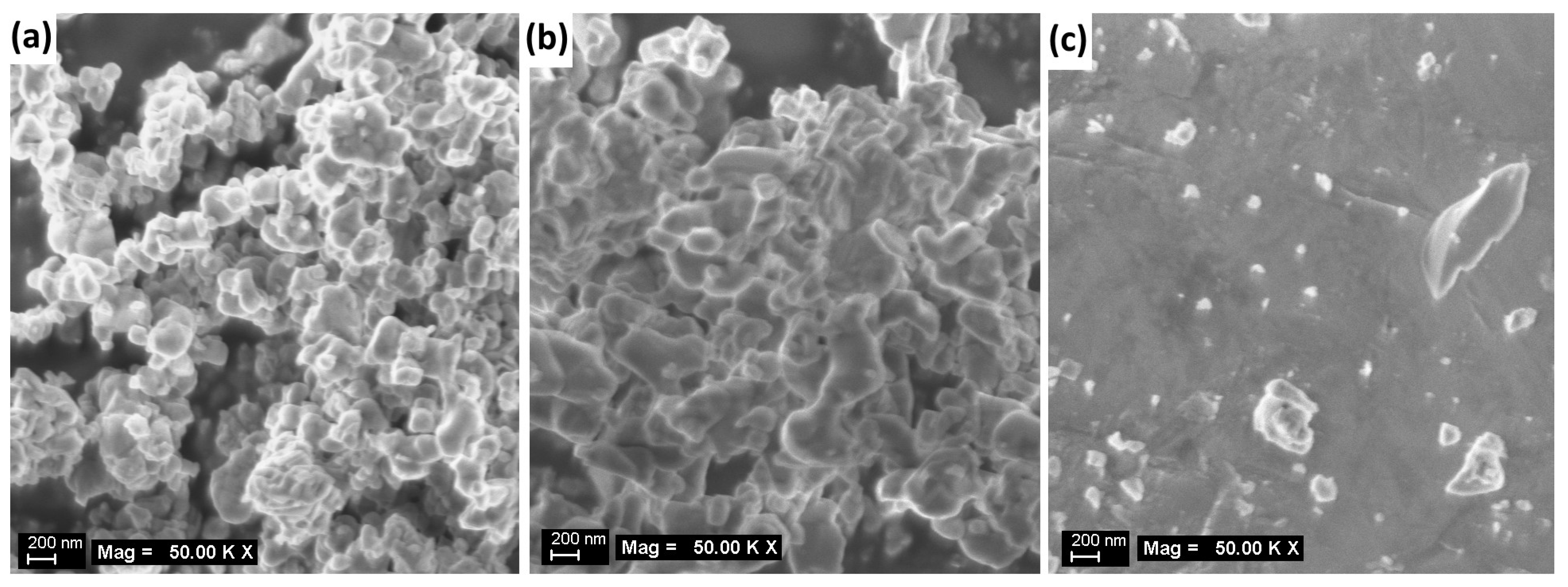

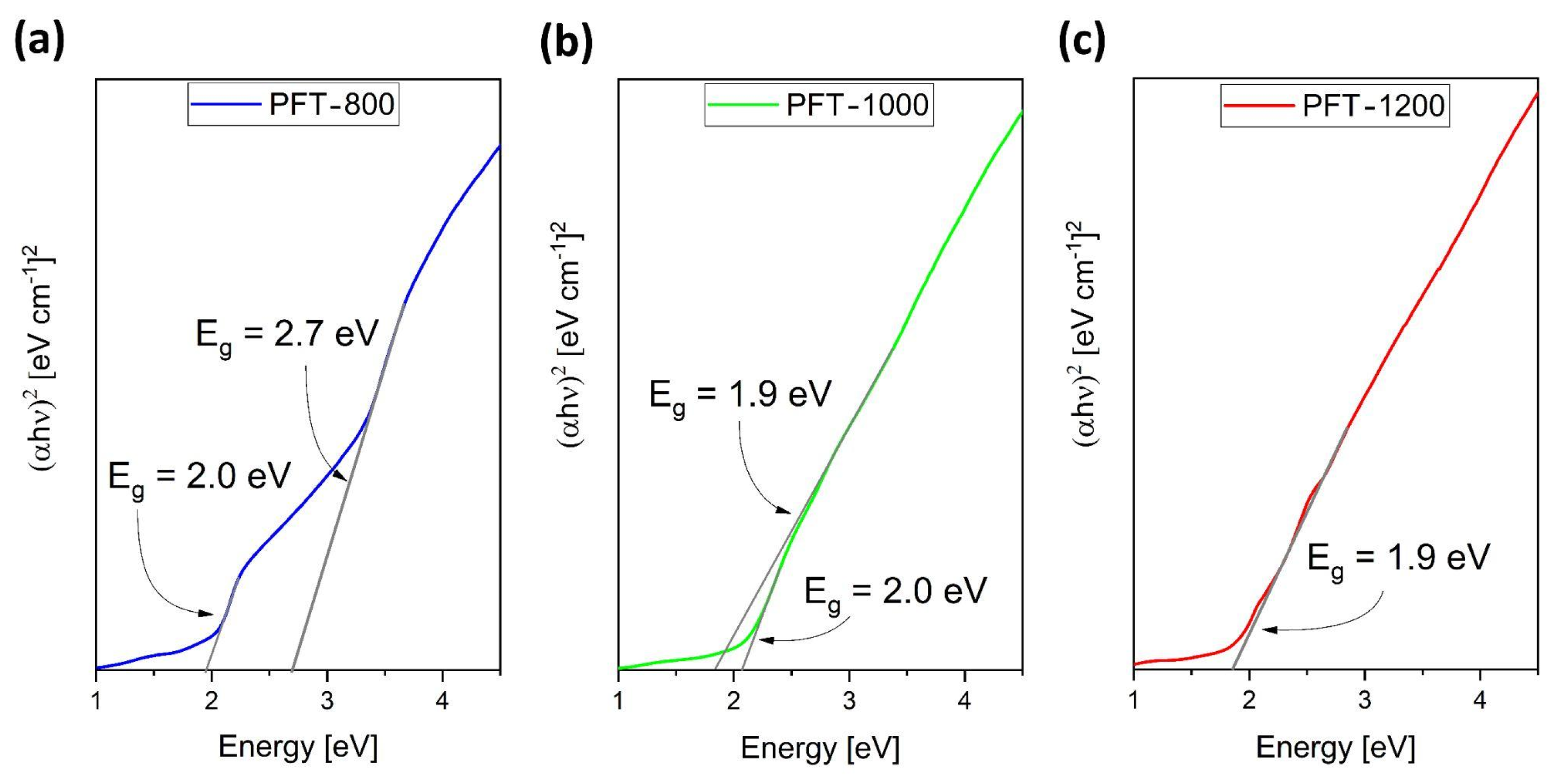
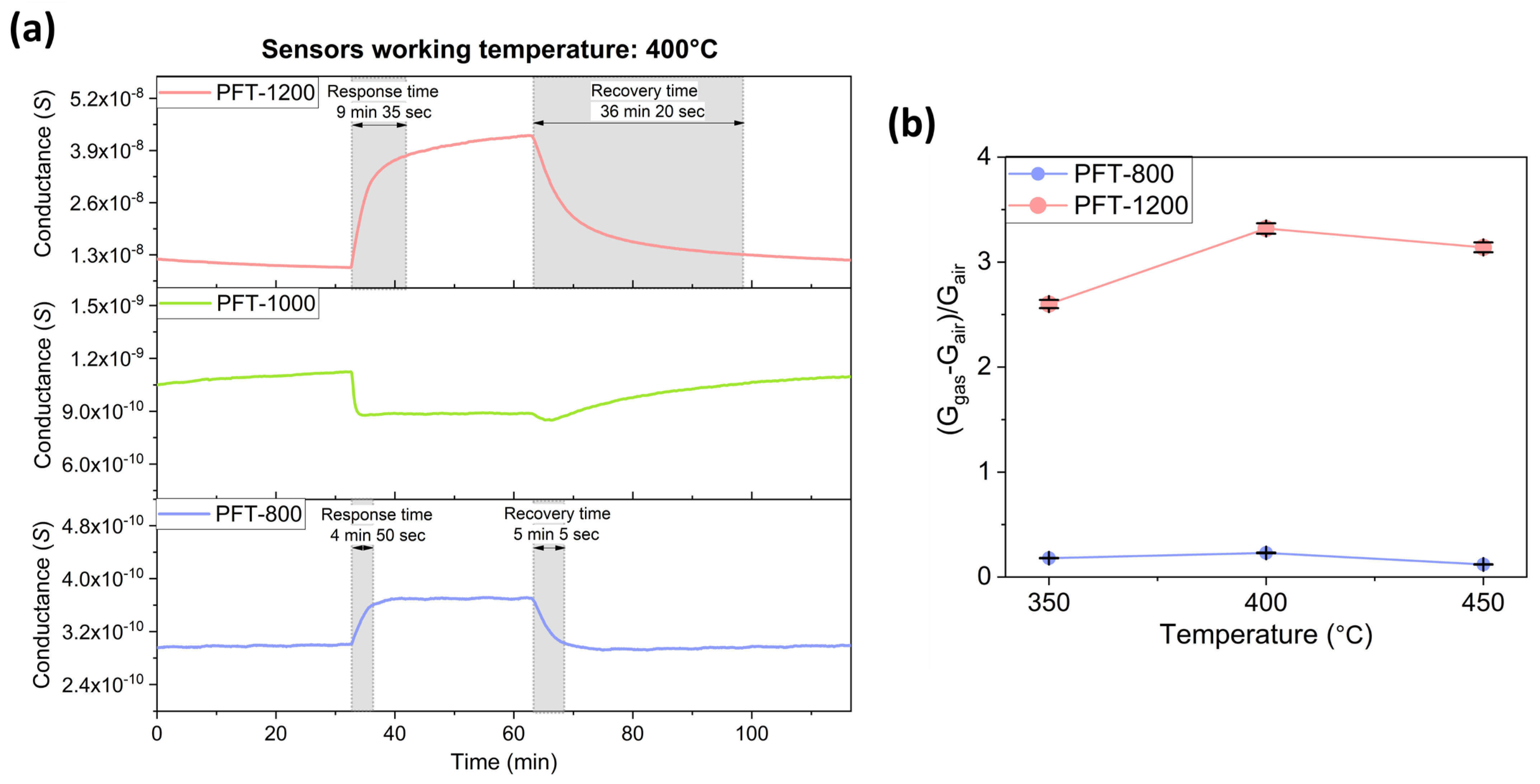
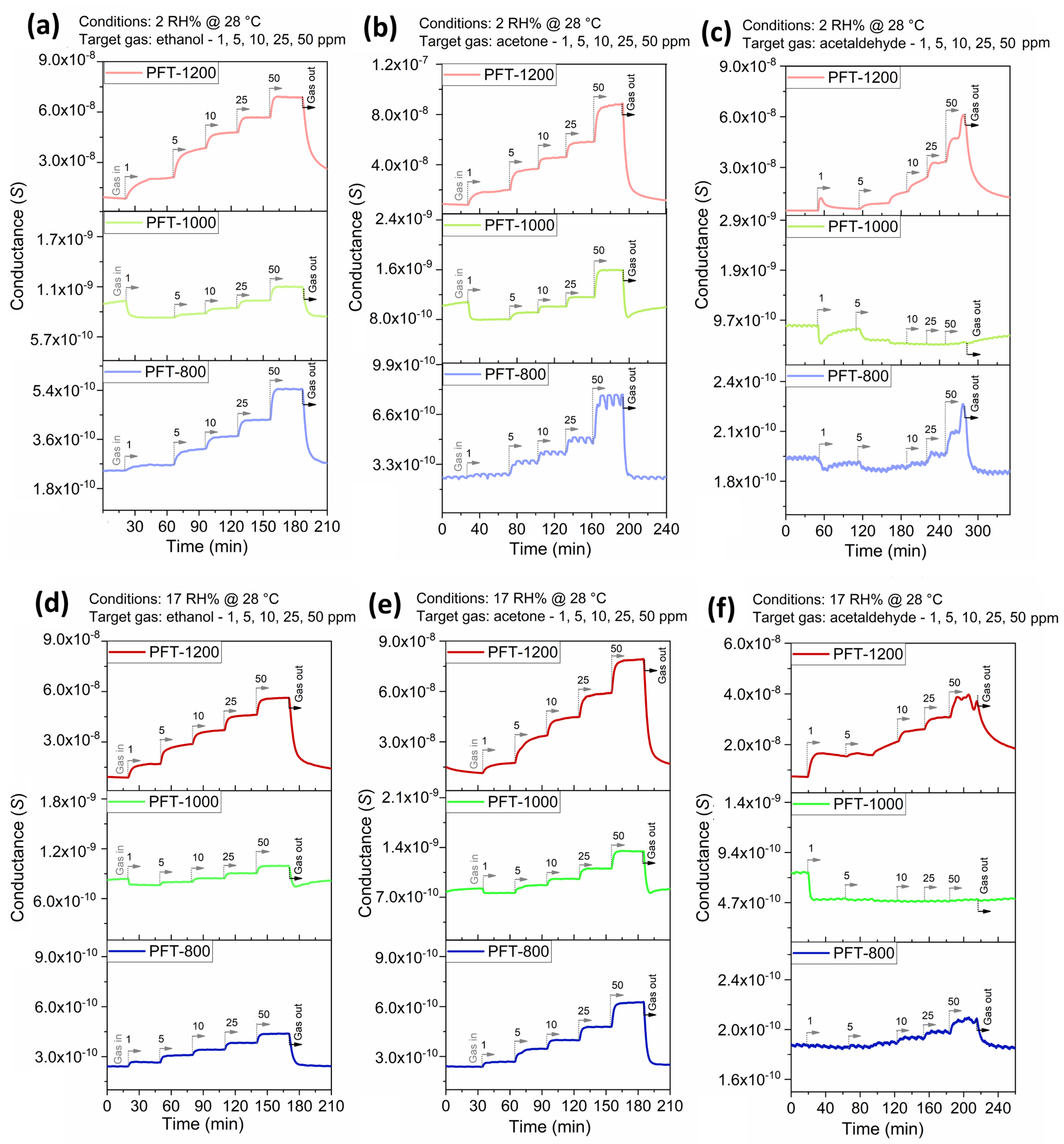
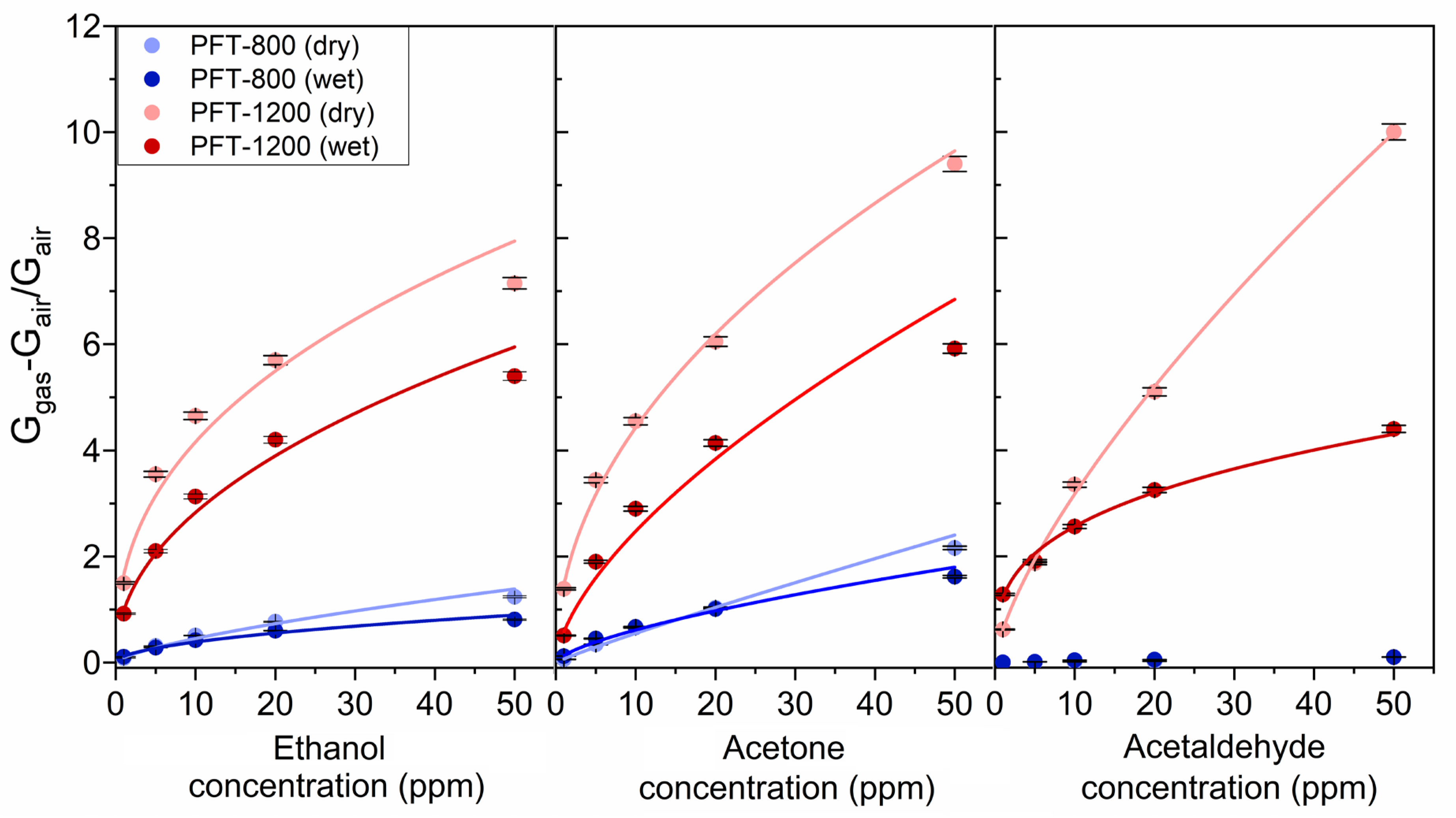
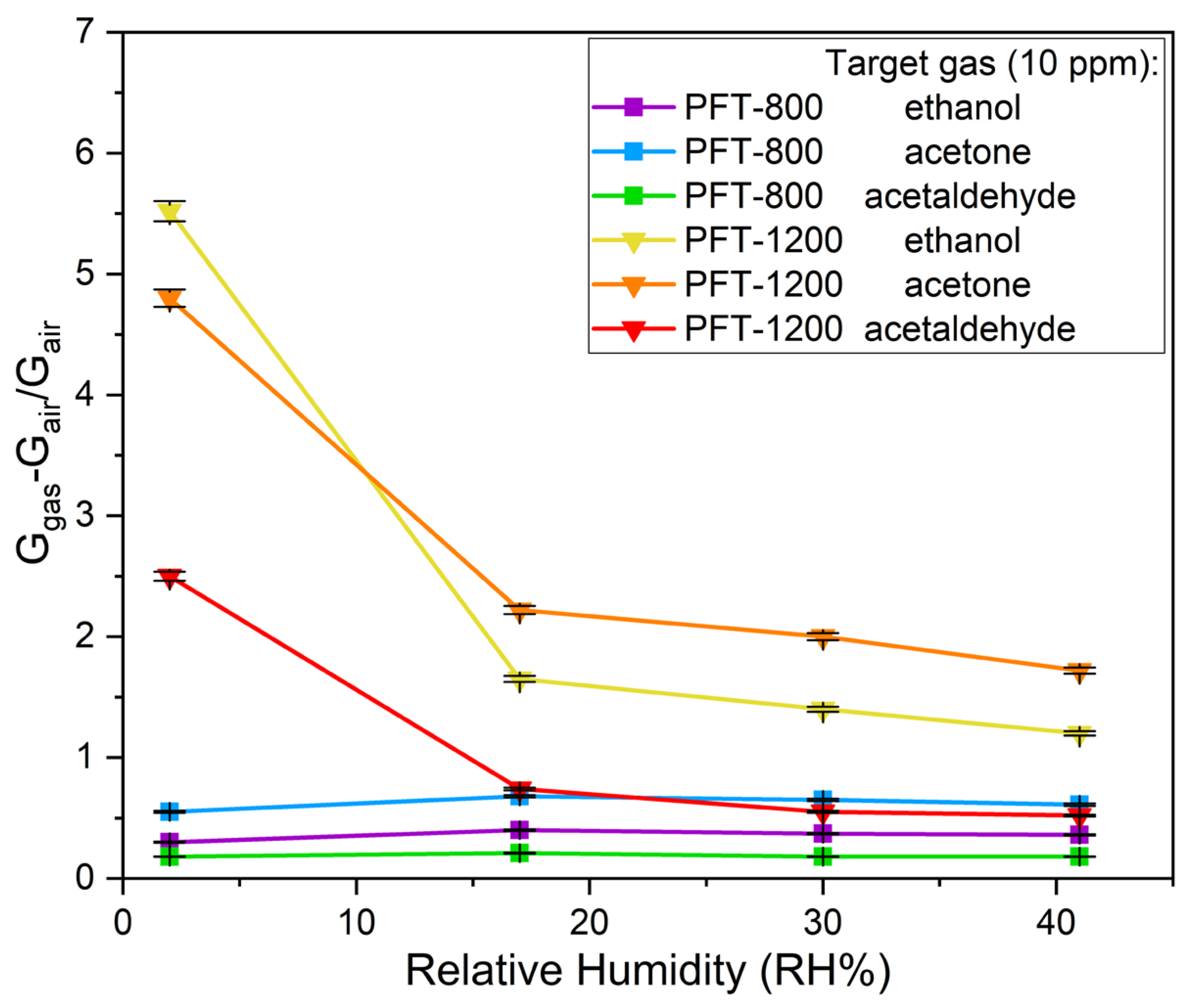
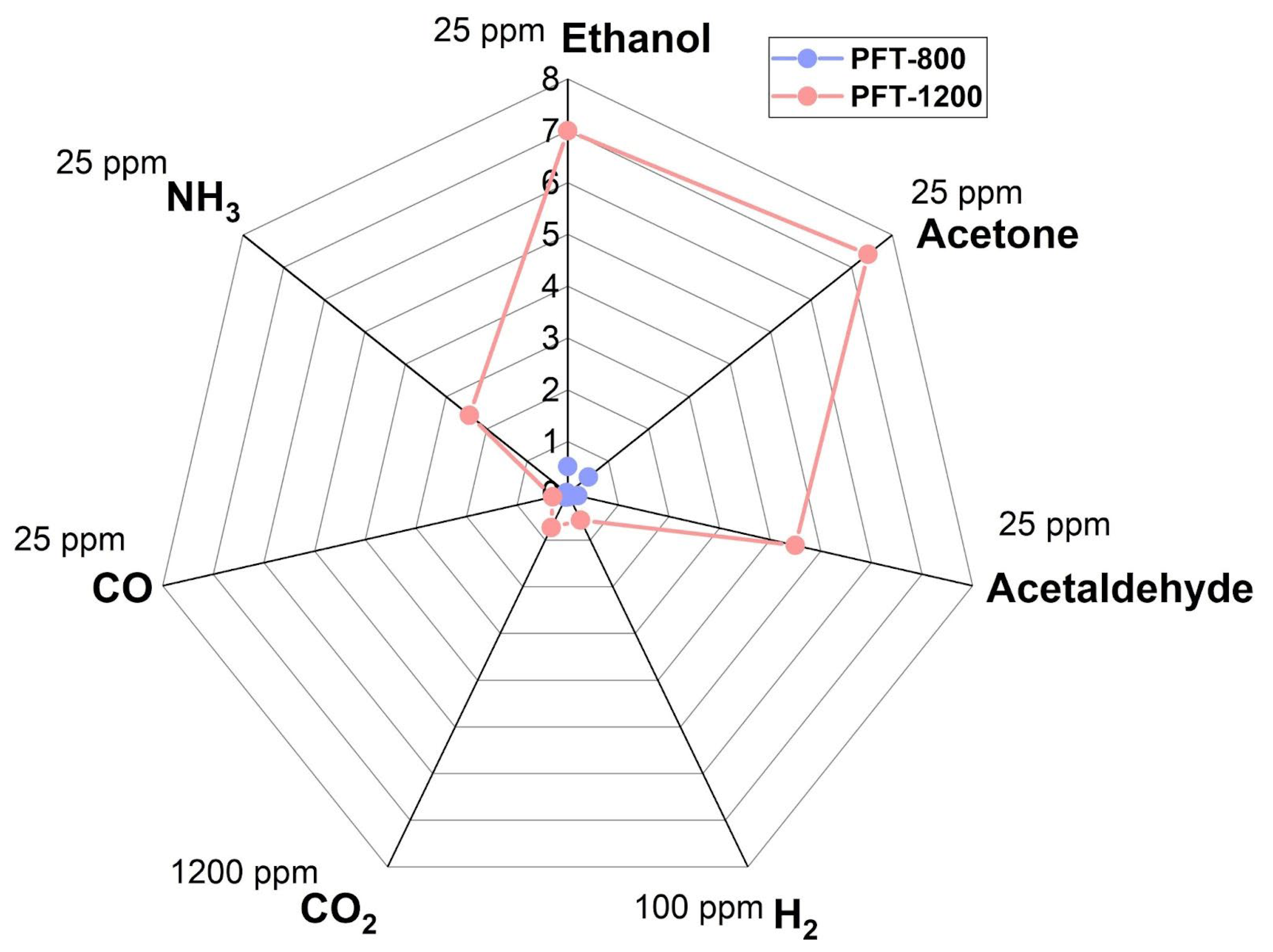
Disclaimer/Publisher’s Note: The statements, opinions and data contained in all publications are solely those of the individual author(s) and contributor(s) and not of MDPI and/or the editor(s). MDPI and/or the editor(s) disclaim responsibility for any injury to people or property resulting from any ideas, methods, instructions or products referred to in the content. |
© 2025 by the authors. Licensee MDPI, Basel, Switzerland. This article is an open access article distributed under the terms and conditions of the Creative Commons Attribution (CC BY) license (https://creativecommons.org/licenses/by/4.0/).
Share and Cite
Ahmed, D.; Spagnoli, E.; Chakir, A.; Mancinelli, M.; Ferroni, M.; Mehdaoui, B.; Bouari, A.E.; Fabbri, B. PrFeTiO5-Based Chemoresistive Gas Sensors for VOCs Detection. Chemosensors 2025, 13, 222. https://doi.org/10.3390/chemosensors13070222
Ahmed D, Spagnoli E, Chakir A, Mancinelli M, Ferroni M, Mehdaoui B, Bouari AE, Fabbri B. PrFeTiO5-Based Chemoresistive Gas Sensors for VOCs Detection. Chemosensors. 2025; 13(7):222. https://doi.org/10.3390/chemosensors13070222
Chicago/Turabian StyleAhmed, Danial, Elena Spagnoli, Adil Chakir, Maura Mancinelli, Matteo Ferroni, Boubker Mehdaoui, Abdeslam El Bouari, and Barbara Fabbri. 2025. "PrFeTiO5-Based Chemoresistive Gas Sensors for VOCs Detection" Chemosensors 13, no. 7: 222. https://doi.org/10.3390/chemosensors13070222
APA StyleAhmed, D., Spagnoli, E., Chakir, A., Mancinelli, M., Ferroni, M., Mehdaoui, B., Bouari, A. E., & Fabbri, B. (2025). PrFeTiO5-Based Chemoresistive Gas Sensors for VOCs Detection. Chemosensors, 13(7), 222. https://doi.org/10.3390/chemosensors13070222






